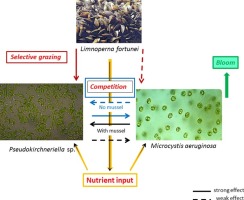Harmful Algae ( IF 5.5 ) Pub Date : 2018-03-08 , DOI: 10.1016/j.hal.2018.02.007 Fabiano Alcísio e Silva , Alessandra Giani

|
Aquatic ecosystems have been severely altered by invasive species and a connection has been observed between bivalve invasions and an increase in frequency of cyanobacteria toxic blooms. In South America, the invasive golden mussel, Limnoperna fortunei, has caused serious environmental and economic impacts, because of its high filtration rates, high population densities and rapid dispersion. Changes in the plankton community have been detected at sites invaded by this species. The aim of the present study was to investigate the possible effects of this mussel on the growth of the bloom-forming cyanobacterium Microcystis aeruginosa, in laboratory experiments under controlled light and temperature conditions. The cyanobacterium M. aeruginosa and a chlorophyte (Pseudokirchneriella sp.) were used either together or alone as food for the mussels. Density measurements of M. aeruginosa and Pseudokirchneriella sp. growing in vessels with and without mussels were performed daily, and nutrient concentrations in the water were assessed at the beginning and end of the experiment. The results indicated that Pseudokirchneriella sp. acted as a competitor, contributing to reduce densities and growth rates of M. aeruginosa. These effects, however, did not occur in the presence of the golden mussel, when the densities of Pseudokirchneriella sp. were significantly lower, possibly due to selective grazing. Phosphate and nitrate concentrations were always higher in the presence of the bivalves. As previously observed for other invasive mollusks, our results suggest that the golden mussel may have a positive effect on M. aeruginosa by the exclusion of potential competitors as well as by increasing nutrient supply.
中文翻译:

侵入性双壳类Limnoperna fortunei存在下形成花粉的铜绿微囊藻的种群动态
入侵物种严重改变了水生生态系统,并且观察到双壳类动物入侵与蓝藻有毒水华发生频率增加之间的联系。在南美,入侵性金贻贝Limnoperna fortunei由于其高过滤率,高人口密度和快速扩散而引起了严重的环境和经济影响。在该物种入侵的地方发现了浮游生物群落的变化。本研究的目的是在控制光和温度条件下的实验室实验中研究这种贻贝对形成水华的蓝藻微囊藻的生长的可能影响。蓝藻铜绿假单胞菌和绿藻(假单胞菌属(Pseudokirchneriella sp。)一起或单独用作贻贝的食物。铜绿假单胞菌和假单胞菌属菌种的密度测量。每天进行带或不带贻贝的容器中的生长,并在实验开始和结束时评估水中的营养成分。结果表明,假单胞菌属。充当竞争对手,为降低铜绿假单胞菌的密度和生长率做出了贡献。但是,当伪贻贝密度高时,在金贻贝的存在下不会发生这些影响。sp。明显降低,可能是由于选择性放牧。在双壳类动物的存在下,磷酸盐和硝酸盐的浓度始终较高。如先前在其他侵入性软体动物中观察到的那样,我们的结果表明,贻贝可能通过排除潜在竞争者以及增加养分供应而对铜绿假单胞菌产生积极影响。











































 京公网安备 11010802027423号
京公网安备 11010802027423号